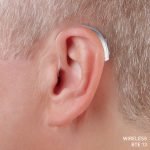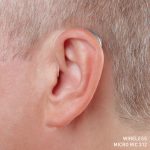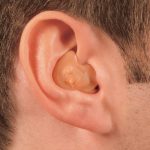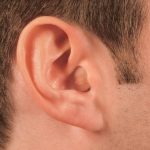Hearing Aids
Hearing aids are small devices that you wear either behind or in the ear. They are supposed to make the sounds that you can’t hear louder and at the same time, not alter the sounds that you can already hear. To do that, all hearing aids must hear the sound by a microphone, make the appropriate sounds louder by an amplifier, and transmit the modified sound to the ear by a speaker.
Hearing aids have changed dramatically over the past 20 years and many of the old assumptions about them no longer apply. Here is a brief review of modern hearing aids and important considerations when selecting them:
Style
Two major types of hearing aids are those that you wear behind the ear and those that you wear in the ear.

In the traditional Behind-The-Ear (BTE) hearing aids, all of the electronics, microphone, amplifier, and speaker, are housed in a plastic casing that sits behind the ear. The sound goes into the ear through a tube and an earmold.
 A newer version of the BTE hearing aid is the Receiver-In-Canal (RIC) aid. In this type of hearing aid, the microphone and amplifier are again housed in a plastic casing behind the ear but the speaker is separated and sits in the ear canal. The speaker, which does not block the ear canal, is connected to the rest of the hearing aid by a thin wire.
A newer version of the BTE hearing aid is the Receiver-In-Canal (RIC) aid. In this type of hearing aid, the microphone and amplifier are again housed in a plastic casing behind the ear but the speaker is separated and sits in the ear canal. The speaker, which does not block the ear canal, is connected to the rest of the hearing aid by a thin wire.
 There are at least three different types of hearing aids that are worn in the ear. The In-The-Ear (ITE) aid contains all of the electronics in a plastic casing that sits in the outer part of the ear canal.
There are at least three different types of hearing aids that are worn in the ear. The In-The-Ear (ITE) aid contains all of the electronics in a plastic casing that sits in the outer part of the ear canal.
 The In-The-Canal (ITC) aids are usually smaller than the ITE aids and are designed to sit inside the ear canal. ITC aids must be custom-made for the shape of the ear canal.
The In-The-Canal (ITC) aids are usually smaller than the ITE aids and are designed to sit inside the ear canal. ITC aids must be custom-made for the shape of the ear canal.
 Finally, the Completely-In-Canal (CIC) hearing aids fit deep in the ear canal and are virtually invisible.
Finally, the Completely-In-Canal (CIC) hearing aids fit deep in the ear canal and are virtually invisible.
In the past, some styles of hearing aids were not suitable for some types of hearing loss. But modern hearing aids have become much more flexible. Today, the choice depends more on one’s lifestyle and personal preferences.
At Sound Hearing and Balance, we will work with you to find the style of hearing that is right for you.
Technology
In the past, hearing aids were made of analog circuits. Analog hearing aids were like the old cassette recorders that converted the sound to electrical signals and processed them to match the hearing loss. Analog hearing aids were programmed by the manufacturer according to the specifications provided by the audiologist. Some analog aids had multiple programs to help you hear in different settings such as quiet room or in crowded areas. Today, analog hearing aids are things of the past and they have been replaced by digital aids.
Digital hearing aids are like miniature computers that first convert the sound to a series of numbers before processing. Digital aids are much more flexible and offer several advantages in addressing your specific hearing needs.
Hearing aids come with many options. For example, some have circuitry that make them easier to use for phone conversations. Other capabilities may include multiple microphones, wireless connections between two hearing aids so that both can be controlled at the same time, or Bluetooth-enabled aids that can be controlled with your smartphone.
Cost is always an important consideration. More sophisticated technology and more options usually mean higher prices. At Sound Hearing and Balance, we work with multiple manufacturers to find the most suitable hearing aid that meets your budget.
Process of getting hearing aids
- The first step in getting new hearing aids is the hearing evaluation. As hearing can change, it is important to have an up-to-date picture of your hearing status. The hearing test can also identify causes that can be addressed without the need for hearing aids.
- The next step is the discussion with the audiologist to review the type of hearing loss, your lifestyle needs, and your preferences. The counseling will help you to choose the best hearing aid that addresses your needs.
- Once the decision is made about the style and technology, the information is then sent to the manufacturer.
- When the manufacturer returns the custom-built hearing aids, you will be contact to come to the office. During this visit, the hearing aids will be fitted and adjustments will be made according to your needs.
- At this time, a trial period will begin. During this period, you can contact the office and return for any necessary adjustments.
- At the end of the trial period, we hope that you have become a satisfied hearing aid user. If not, we can try other options such as changing the style or technology or even returning the hearing aids completely. It is important to recognize that hearing aids do not restore your normal hearing. But over time, hearing aids can substantially improve the functionality and help you hear better.
Repairs and Adjustments
In addition to fitting, we can repair or adjust your existing hearing aids. If there is any problem with your hearing aid, please call us. During the warranty period, all repairs and adjustments are done at no cost to you.
Again, at Sound Hearing and Balance we will work with you to find the hearing aid that feels right, it fits right and, it sounds right.
Click hear to find more detailed information on hearing aids from the National Institute on Deafness and Other Communication Disorders.

